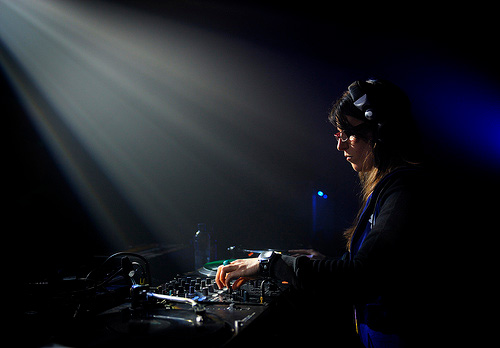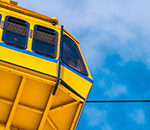You don’t need fancy, high-end, expensive equipment for nightclub photography. Any decent prosumer level DSLR kit and a flashgun that’s fully compatible with the camera body and supports i-TTL (Nikon) or E-TTL (Canon) modes will do.

“Subtopia” captured by JKphotography.nl
Since all the photographs will most likely be resized for use on the web, megapixels also don’t matter. Even if you’re expected to submit high resolution photos, unless they’ll be used to print huge—and I mean huge—posters or banners, you don’t really need more than 6 megapixels to get the work done. The only thing that I’d suggest to really think investing in, if you are serious about photography, is a ”fast” lens with a fixed aperture value.
Fast Lenses
”Fast” is a term usually used to describe lenses with maximum aperture value of f/2.8 and below (f/1.8, f/1.4, f/1.2). If you’re still using a kit lens, take a look at the writing on it now; you’ll probably see something like 18–55mm, which describes the focal range covered, followed by 3.5–5.6, which means that at 18mm the maximum aperture opening of this lens is f/3.5 and at 55mm the maximum aperture opening will be f/5.6. Therefore, the aperture is not fixed throughout the focal length of this lens and changes as you zoom in or zoom out and can result in some inconsistency.
For instance, I use a Sigma 24-70mm f/2.8, so if I set the aperture value of f/2.8 it will stay at 2.8 whether I’m shooting at 24 or 70mm. By now you probably understand why I started by suggesting a lens with a ”fixed” aperture. These lenses are not cheap, but they are worth it, providing more predictable results and consistency. They’re also generally better in terms of built and optical quality.
Consider buying used equipment, and if you’re on a budget, instead of going for Nikon or Canon lenses, look for lenses from other manufacturers such as Sigma, Tamron, Tokina, etc. Lenses with focal lengths of 17–70 or 24–70 are, in my opinion, optimal choices for nightclub photography.
Flash Diffusers
Now I’d like to talk about some accessories that nightclub photographers use to improve picture quality. Assuming that you already own an external flash unit, which is very important for nightclub photography, the first accessory worth mentioning is a flash diffuser that attaches to the tip of the flashgun. Contrary to what many people think, it doesn’t really diffuse light per se, it spreads the light, producing much softer lighting as a result. They are very cheap and you can get one of eBay or Amazon. You don’t really need any bulky, expensive light spheres and other bigger types of diffusers. Although, they do produce excellent results and some photographers use them for weddings and even in a studio, they are just too bulky to carry around in a nightclub and are very likely to fall off the tip of your flash gun; sooner or later someone will surely step on it.
While we’re on the subject of lighting, I might as well get it out of the way by suggesting that you should never point the flash directly at your subject, as it will not only make the background very dark, but also produce very harsh shadows. Instead turn the flash head up, whether you’re photographing in landscape or portrait format, and bounce the light off the ceiling. As you gain more experience you’ll learn to read the surroundings well and sometimes even bounce the light off the walls for a different result. I will talk more about flash settings later.
Lens Hoods
The second very important accessory is a lens hood. Not only it is very important from a picture quality perspective as it helps you avoid getting lens flares and produce better overall contrast in your photos, but it will also protect the front element of your lens. For instance, if you accidentally hit the lens against a wall or a bar stand, or some lady rubs her purse against it, the hood will protect the front element from getting scratched. Although not all the kit lenses come with a hood, you can still purchase one. It’ll probably either be a rubber type that pops on or a threaded one that screws into the filter thread of your lens. Both types are absolutely fine!
The next three accessories that I’m about to mention are, in my opinion, purely about personal preference.
UV Filters
Many nightclub photographers suggest that you use a UV filter. A UV filter is a clear piece of glass which screws onto the tip of the lens in the case of nightclub photography mainly for protection. To be honest, I’m not a big fan of those, I think they limit some amount of light entering the lens, producing somewhat duller results. Of course you can use a UV filter and compensate for the difference in the final results by slightly changing some settings on your camera, if you want a bit more protection for your lens. In other words, it’s entirely up to you if you want to use one or not. If you do decide to purchase a UV filter, I suggest you go for more expensive, pro quality filters. Cheaper filters will obviously degrade quality by causing ghosting, glares, etc. There are many types of UV filters out there; they come single coated, double coated, etc. Just do some research before you purchase one.

“stage16” captured by Ikmal Fauzan
Vertical Grips
Another piece of equipment that I want to discuss is a vertical grip. You can purchase a vertical grip from manufacturers other than Nikon or Canon. For instance, Hahnel produces good quality grips for almost half the price, and they do a great job. I’ve used a Hahnel grip on my Nikon D90 for about two years and sold it along with my camera in top working and cosmetic condition. Again, this accessory is all about personal preference and all it does is make it slightly easier to handle your camera when you take photos in a portrait format, as it lets you hold the camera much in a same way as you would in a landscape format. As a bonus you also get a second battery slot for a spare battery, which is helpful if you have a long night of shooting.
TTL Off-Camera Shoe Cords
Finally, the last piece of equipment that I’ll be talking about is a TTL off-camera shoe cord. This cord is the cheapest and probably one of the most reliable ways to get the flash off your camera without losing any functionality of the flashgun. Off-camera lighting is a completely different topic, but you can experiment by holding your flashgun in one hand and the camera in another and you’ll notice the difference in the way people are lit as you move the flashgun to the left, right, or even above your camera. Alternatively, you can use wireless triggers, or if you’re a Nikon user most of the recent cameras support CLS (Creative Lighting System), which allows the camera to act as a master unit and trigger the flash gun wirelessly, even if it’s not mounted on the camera body. This function works only with Nikon flashguns such as SB-600, SB-800, SB-900, etc. Earlier models don’t support it. Refer to the user manual to find out how exactly to set your camera and flash to communicate wirelessly.
About the Author
This article was written by Rauf Ashrafov (raufphotography dot com).
Like This Article?
Don't Miss The Next One!
Join over 100,000 photographers of all experience levels who receive our free photography tips and articles to stay current:





One thing I would add for flash use is use Rear Curtain Sync. Freezes your subject at the end of the exposure which is helpful in darker situations where the shutter may be open longer. Also, you can do some creative blurring with a flick of the wrist and still capture the subject nice and sharp.
I have been looking for this type of information and guidance for a while now and this was great. I love all of the blunt information and the images were beautiful and amazing! Thank you so much for this article.
Sacred :O)
very good!
Gonna try this out at our next exhibition opening.
Thnaks alot!
Regards Paul
Good article. While I usually try to stay with available light, you can’t beat using a little fill flash.
That’s Ok but most of club would just simply refuse that you shoot with a flash and this is pretty understandable as it could be very annoying for the band, audience, dancers, etc.
UV filter have no effect on digital lens, just a protection purpose.
The SB-600 cannot be use as a trigger for the other flash. You need to get a hot shoe trigger, a SB-800 or 900 as a main flash and use the SB-600 as a triggered flash.
I don’ think that carrying a shoe cord is a good ideal in an environnement like club with all the risk belong to this kind of situation (drunker, over excited people, etc.).